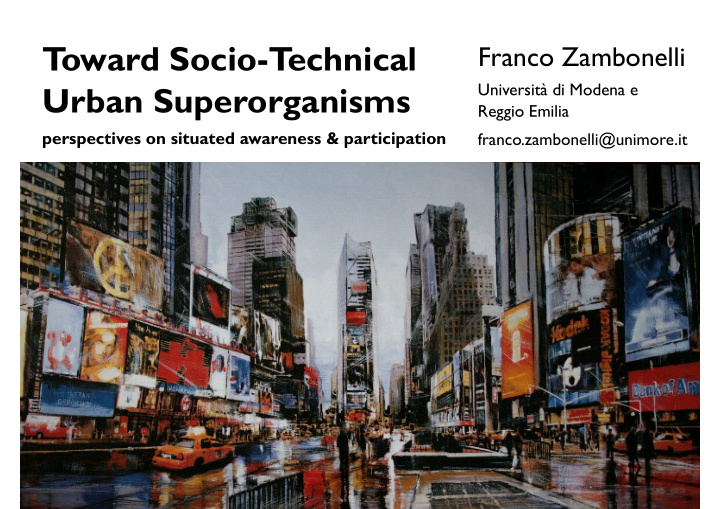



T oward Socio-T echnical Franco Zambonelli Università di Modena e Urban Superorganisms Reggio Emilia perspectives on situated awareness & participation franco.zambonelli@unimore.it
Collective…What?
E Pluribus Unum
E Pluribus Unum
E Pluribus Unum
Superorganisms • Colonies ¡of ¡ants, ¡termites, ¡ etc. ¡ • Organisms ¡composed ¡of ¡ many ¡individual ¡ones ¡ • That ¡exhibit ¡finalized ¡ collec>ve ¡par>cipa>ve ¡ behaviors ¡(or ¡“collec>ve ¡ intelligence”) ¡
Urban Superorganisms • Can ¡our ¡urban ¡ environments ¡become ¡ superorganisms? ¡ • What ¡could ¡this ¡actually ¡ mean? ¡ • Why ¡socio-‑technical? ¡
Smart Cities: From Senseable… • Sensing what’s happening Sense ¡ – Via ICT devices – And social networks • To better understand (via data analysis) Understand ¡ – City and social (compute) ¡ dynamics – At a global level
…T o Actuable • We can “shape” other than Act ¡ understand Sense ¡ (Steer) ¡ – Actuating ICT devices – Steering human actions • Closing the loop Understand ¡ that enables (compute) ¡ finalized urban behaviors possible
…T o Actuable • We can “shape” other than Act ¡ understand Sense ¡ (Steer) ¡ – Actuating ICT device – Steering human actions • Closing the loop Understand ¡ that enables (compute) ¡ finalized urban behaviors possible
Urban Superorganisms: ICT Side • An ICT -enriched urban environment with rich sensing, actuating, and computing (SAC) capabilities – Sensing : sensor networks, tags, smart objects,etc. – Actuating : traffic controllers, public digital displays, critical infrastructures – Computing : highly distributed and decentralized, with inter-connected computational engines everywhere
Urban Superorganisms: Human Side • People with smart phones or alike (or whatever will appear in the future as wearable devices) contribute to such SAC capabilities – Sensing : the 5 senses + smart phones – Actuating : the body – Computing : human & social intelligence
Urban Superorganisms: Putting All T ogether • The ICT and Human/Social level blurred to the point of invisibility: • Complementing each other in a process of high value co-creation • In the resulting overall “urban organism”, we can achieve very high-levels of collective – Perception – Awareness – Action • Dramatically changing the way we move, live, work, and play, in our towns
Living in a Superorganism • Collective vs individual awareness – Reflecting on ourselves as members of a community • Be capable of understanding and acting together in real time – Immediate feedback to/from the community
Collective Mobility, for Instance • Mobility per se :: steer for car, bike, ride sharing • Childcare :: steering & monitoting children on their way to school • Exhibitions :: steer to avoid crowd or suggest paths • All of these requiring collective sensing awareness and action • And relying on a trade off between bottom up self- organization of behaviors and top-down behavior steering
Traffic Steering: T op-down non participatory design
Traffic Steering: bottom up self-organizing solution
Traffic Steering: mixing top down and bottom up
Traffic Steering: Future socio-technical superorganims By Prof. Peter Stone @UTA.edu
The SAPERE Project • SAPERE “ Self-aware Pervasive Service Ecosystems ” – EU FP7 FET – Starting October 1 st 2010, lasting 3 years • Key Challenges – To define and implement a framework for adaptive service ecosystems – Models + Middleware – Experience with pervasive urban services and pervasive displays
The SAPERE Approach • Nature-inspired (Biochemical) – Simply metaphor for combining/aggregating services in a spontaneous way – Whether human or ICT ones • Spatially-situated – To match the nature of urban scenarios – Adaptive – Spontaneous reconfiguration of activities and interactions
The SAPERE Architecture • Humans & ICT Devices – Interact by injecting/ consuming service/data components • Service Components – Execute in a sort virtual “ Spatial substrate ” – Moving, acting, composing, as from eco-laws • Eco Laws – Rule local activities and interactions – Apply based on state of local components – Self-organization of collective behavior
Steering Mobility in SAPERE
Steering Behaviors in SAPERE with an Ecosystem of Displays
Open Challenges Tools to engineer What programming languages and abstractions? Role of existing social networks in future ecosystems? Engineerng and controlling emergent behaviors How to find the proper tradeoff between top down design and bottom up self-organization What you steer is what you get? Incentives for human participation Reputation, virtual money, situated games, or what?
Conclusions • Our future cities will become sorts of superorganisms • Human & ICT tightly coupled • Collective participation and action • How can we engineer these? • SAPERE is doing some steps in the right direction • Yet there are a lot of challenges to solve
Recommend
More recommend